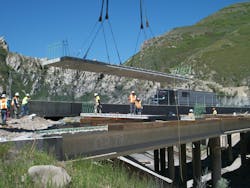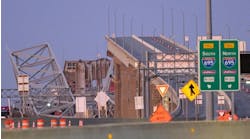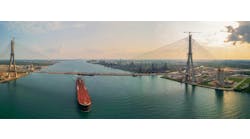By Darren Medeiros, Contributing Author
In its most recent Infrastructure Report Card, the American Society of Civil Engineers (ASCE) paints a concerning picture: 42% of the country’s 617,000 bridges are at least 50 years old, and over 4,600 are considered structurally deficient.
Nearly $40 billion has been allocated for bridge repair and replacement under initiatives like the Bipartisan Infrastructure Law (BIL). Along with state funding options, this investment in infrastructure has driven change to remedy America’s bridge problem. However, the money must be spent efficiently.
Advanced materials and techniques can help stakeholders grapple with the challenge of improving infrastructure efficiently. Precast concrete components have emerged as a key solution among engineers and officials from state departments of transportation.
Manufactured in controlled factory conditions, precast bridge components like girders, seats, wing walls and piles consistently meet high-quality standards and contribute to a more precise construction process.
Off-site production enables concurrent construction eliminates time for extensive on-site formwork and curing. This time-saving option allows professionals to adhere to tight schedules, which is especially critical during road and bridge repair projects.
However, because precast, prestressed concrete must be shipped to the jobsite, it can contribute to significant transportation costs. In addition, shipping and other logistics limitations around the use of precast concrete components can cause construction delays in a project.
Using precast, prestressed members made with structural lightweight concrete (SLC) addresses these challenges.
When made with expanded shale, clay or slate (ESCS) lightweight aggregates, SLC precast members can be up to 35% lighter than normal weight precast components, and durability and resilience are not compromised. This material helps meet structural requirements while also reducing the limitations of conventional concrete bridge elements.
The Concrete Matters
Precast, prestressed components made with normal weight concrete (NWC) typically weigh between 145 to 155 pounds per cubic foot (PCF). These concrete members often exceed truck load limits without reaching optimal span lengths.
This necessitates a higher number of shipments to transport the required number of bridge components to the site. This can lead to delays and complicated coordination efforts for the on-site teams, which may increase a project’s total construction costs.
Components made with SLC weigh a more manageable 110 to 115 PCF. Additionally, ESCS’s greater surface area and pozzolanic surface enhance concrete quality by supporting a stronger bond between the aggregate and the cementitious mix.
The reduced dead load of SLC lowers the seismic inertia of a system. Hence, structural designers can achieve the desired load capacity with less reinforcement, further lowering the structure’s overall weight and size.
Because ESCS is expanded and vitrified in rotary kilns, it helps reduce SLC’s density. This allows prestressed girders and other precast elements to be made larger in size but still lighter as compared to NWC components of similar size. As a result, these large components can still fit within truckload limits, helping reduce the number of shipments required to complete a project.
As demonstrated in “A Holistic Approach to Sustainability for the Concrete Community,” lighter concrete components can have a net positive impact on a project’s overall cost. In the review, two projects by Big River Industries are analyzed to determine the differences in projected shipping costs between NWC and SLC products.
As more material could be loaded on each truck due to the lowered density, the number of truckloads of precast concrete elements was reduced from 431 to 287 in the first project and from 87 to 66 in the second. These projects reduced logistical challenges and transportation expenses, efficiently managing project costs.
Cost-Efficient Construction
Besides more efficient delivery of required component quantities, the installation of SLC precast prestressed components is more straightforward. Heavier NWC components often require large overhead cranes. They may be unfeasible in some locations.
In contrast, SLC components can be placed with smaller rated cranes, which are generally more available. This flexibility helps streamline installation requirements and timelines.
Larger component sizes reduce the number of parts to be placed, allowing engineers and DOTs to ensure more efficient installation. This results in faster completion of bridge girder and deck construction as well as repair projects.
For instance, the Interstate-5 southbound Puyallup River Bridge near Tacoma, Wash. used precast SLC components to extend the length of the bridge girders to an unprecedented 223 feet and 4.5 inches, surpassing conventional girder lengths by more than 13 feet.
The record-breaking size enabled construction crews to manage tight schedules, as a railway directly below a portion of the bridge required crews to halt work whenever a freight train passed underneath. Streamlining this aspect of construction helped minimize labor hours and revenue lost due to interruptions, ensuring the project's efficient completion.
By using precast components made with SLC, engineers and DOT officials can address commonly faced jobsite logistic limitations. This approach allows them to appropriately utilize government funds while working to improve national infrastructure.
Structural Stability
Bridge repair projects often require careful consideration, especially when dealing with existing foundation systems that may not be able to withstand additional heavy loads.
The heavier nature of NWC-precast slabs poses a risk of overwhelming the structural system in such cases, which may require extensive improvements, increasing project costs and timelines. SLC-precast has proven material strength and lower self-weight that helps ease additional loads.
SLC’s higher strength-to-weight ratio reduces the need for extensive foundation interventions for bridges undergoing repair. Thus, SLC not only contributes to construction efficiency but also enhances structural efficiency.
In some cases, SLC enables bridge upgrades and expansions without the need for additional support foundations. Consequently, bridge repair teams can achieve structural stability while using fewer building materials in bridge deck repairs by employing precast components made with SLC.
The building team involved in the replacement of the collapsed steel truss on the I-5 bridge over Skagit River in Washington leveraged these benefits. After thoughtful consideration, the team opted for SLC deck girders (a full-depth deck was cast monolithically with the pre-tensioned girders) for the permanent replacement span.
This decision allowed them to keep the total weight of the new span below 918 tons. It also enabled them to utilize existing foundations without the need for reanalysis or strengthening. This approach resulted in a faster, cost-efficient construction process.
Cost-Saving Benefits
Despite its added logistics and performance benefits, SLC-precast slabs are often considered expensive because of the concrete’s cost. Indeed, the material unit cost of SLC is typically higher than that of NWC, but the unit cost usually is offset by the overall reduction in concrete volume and steel tonnage for the structural system.
To give a comparative analysis, Table 1 illustrates the relative costs of materials and girders using SLC and NWC girders based on data from the Skagit River Bridge and two similar projects.
Although the costs of the LWA and SLC are greater than the comparable NWC mix, it is important to note that the aggregate was shipped from North Carolina to the prestress plant in Tacoma, Wash.
Despite this additional logistical cost, the price of the SLC girder was only 13-14% higher than that of an NWC girder. This minor difference is because the cost of LWA represents a relatively small portion of the total cost for a girder.
The relative girder costs presented in the table do not reflect the significant savings expected in trucking, erection, substructure, design effort, material costs and scheduling, all of which are likely to further compound cost savings with the use of SLC-precast girders.
Building professionals have utilized SLC to support cost-effective high-rise design, and the general thought can be applied to bridge repair and replacement.
While SLC may have a higher initial unit cost, SLC-precast components’ overall cost-effectiveness when considering the entire project lifecycle and associated savings makes them compelling solutions for bridge construction and repair projects.
When used in precast concrete components, SLC made with ESCS LWA offers construction teams significant benefits in easing logistics and enhancing performance. These advantages support shorter construction timelines, which contributes to cost-effectiveness through reduced material volumes and improved structural efficiency over the project’s lifecycle. Additional properties of SLC with ESCS further enhance component performance and support an extended service life.
By leveraging these advantages, construction teams and government officials can ensure optimal use of federal resources, contributing to sustainable infrastructure development. This innovative approach not only meets immediate project needs but also lays a foundation for a more resilient and longer-lasting bridge infrastructure in the country. RB
Darren Medeiros is a regional technical salesperson at Holcim Lightweight Aggregates — Utelite Plant.



